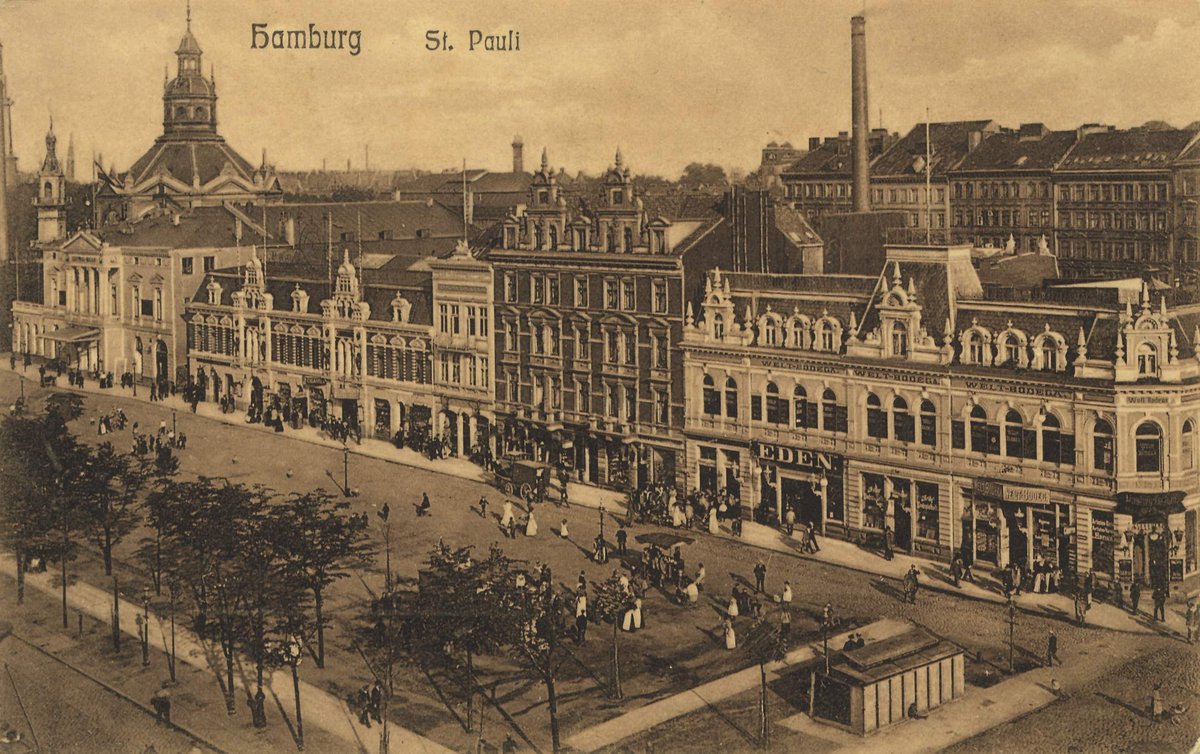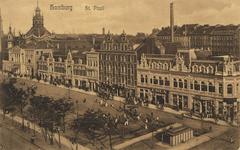
Reeperbahn Hamburg: Visiting Hours, Tickets, and Travel Guide
Date: 14/06/2025
Introduction: The Reeperbahn’s History and Cultural Significance
The Reeperbahn, famously known as Hamburg’s “sinful mile,” is one of Europe’s most legendary entertainment districts. Originating in the 17th century as a rope-making street—hence the name, which means “ropewalk”—the Reeperbahn has transformed into a vibrant nexus of nightlife, music, theater, and multicultural experiences. Its journey from serving sailors and dockworkers to becoming a renowned red-light district and music hotspot mirrors Hamburg’s openness and cosmopolitan spirit. Notably, it was here that The Beatles honed their craft in the early 1960s, an era celebrated at Beatles-Platz (Hamburg Travel; likethebeatles.com). Today, the Reeperbahn is a multifaceted destination offering theaters, live music, festivals, diverse dining, and a unique cultural atmosphere. This comprehensive guide provides detailed information on visiting hours, tickets, travel tips, and nearby attractions, ensuring a safe and engaging visit to Hamburg’s most iconic street (travelsetu.com; Audiala).
Table of Contents
- Introduction
- The Reeperbahn’s Historical Evolution
- Key Landmarks and Cultural Highlights
- Visiting Hours and Best Times to Visit
- Ticketing and Guided Tours
- Accessibility and Transportation
- Safety and Local Customs
- Nearby Attractions
- Annual Events and Festivals
- Practical Tips and Frequently Asked Questions (FAQ)
- Summary and Recommendations
- References
The Reeperbahn’s Historical Evolution
Maritime Roots
The Reeperbahn’s heritage is grounded in Hamburg’s maritime history. Established in the 17th century in the St. Pauli district, rope makers—“Reeper”—produced the ropes vital to the city’s thriving port (Hamburg Travel). Its location near the Elbe River and harbor naturally attracted sailors and tradespeople, laying the foundation for the area’s lively character.
Transition to Entertainment District
As Hamburg’s port grew, the Reeperbahn evolved. By the 19th century, the district was bustling with bars, theaters, and boarding houses that catered to sailors and travelers. The area’s liberal atmosphere encouraged the growth of a vibrant entertainment scene, which expanded further in the 20th century, particularly with the rise of cabarets, music halls, and later, nightclubs.
The Beatles and Pop Culture
A defining era began in the early 1960s, when The Beatles played extensively in clubs like the Indra Club, Kaiserkeller, and Star-Club. Their formative Hamburg years are immortalized at Beatles-Platz and continue to attract music fans from around the world (likethebeatles.com). The district’s reputation as a launching pad for musical innovation persists, with venues spanning genres from jazz and punk to electronic.
Key Landmarks and Cultural Highlights
- Herbertstraße: The most notorious red-light street, restricted to men over 18, reflecting Hamburg’s pragmatic approach to vice (Hamburg Travel).
- Davidwache Police Station: An architectural and cultural icon, serving as the district’s police hub since 1840.
- Beatles-Platz: A public square celebrating The Beatles’ legacy.
- Theaters: Including the St. Pauli Theater (Germany’s oldest private theater), Schmidt Tivoli, Imperial Theater, and Stage Operettenhaus, offering diverse performances and musicals (manvsglobe.com).
- Music Clubs: Legendary venues such as Molotow, Große Freiheit 36, and Docks host international and local acts (germanytravel.blog).
Visiting Hours and Best Times to Visit
- District Access: The Reeperbahn is a public street, open 24/7.
- Nightlife: Most bars, clubs, and theaters open from 8 or 9 PM until early morning (often 3–6 AM).
- Daytime: Quieter, ideal for exploring cultural attractions, museums, and historical sites.
- Best Experience: Thursday to Saturday nights offer the liveliest atmosphere; weekdays and earlier evenings are less crowded.
- Festival Season: The annual Reeperbahn Festival in September draws larger crowds and extended opening hours (Reeperbahn Festival).
Ticketing and Guided Tours
- Walking the District: Free of charge.
- Clubs, Theaters, and Museums: Entry fees range from €5–€80 depending on the venue or event. Notable venues include Schmidt Tivoli, Stage Operettenhaus, and the Erotic Art Museum (Hamburgausflug.de).
- Guided Tours: Themed walking tours (historical, Beatles, nightlife) cost €15–€25 and last 1.5–2 hours. Advance booking is recommended, especially on weekends.
- Festival Tickets: The Reeperbahn Festival requires tickets, with passes available online (Reeperbahn Festival).
- Accessibility: Many venues are wheelchair accessible; confirm specific requirements with individual locations.
Accessibility and Transportation
- Public Transport: The Reeperbahn is easily accessed via the U-Bahn (U3 line, St. Pauli station), S-Bahn (Reeperbahn station), and local buses.
- Parking: Available but limited; public transport is advised, especially during events.
- Taxis: Readily available; use licensed services (strspecialist.com).
- Disabled Access: Most theaters and main venues offer accommodations, but some older buildings may have restrictions.
Safety and Local Customs
Safety Tips
- General: The Reeperbahn is generally safe, but standard caution is advised, especially at night and in crowded venues (Audiala).
- Pickpocketing: Remain vigilant in busy areas; keep valuables secure (beoriginaltours.com).
- Red-Light District: Herbertstraße is off-limits to women and minors; respect signage and local customs.
- Police Presence: The Davidwache police station ensures a visible law enforcement presence.
- Solo Travelers: Safer to explore in groups after dark.
Local Customs
- Dress Code: Generally casual, but some clubs require smart attire.
- Photography: Permitted in public spaces, but prohibited on Herbertstraße and in adult venues.
- Tipping: 5–10% is customary in bars and restaurants.
- Age Restrictions: Most nightlife venues are 18+; carry valid ID.
Nearby Attractions
- St. Michael’s Church: A baroque landmark with panoramic city views.
- Elbphilharmonie: Hamburg’s modern concert hall and architectural marvel.
- Miniatur Wunderland: The world’s largest model railway and family favorite.
- Planten un Blomen: A scenic park ideal for daytime excursions.
- Speicherstadt: The historic warehouse district, UNESCO-listed and rich in maritime history.
Annual Events and Festivals
- Reeperbahn Festival: Europe’s largest club festival, held every September, featuring 900+ concerts and creative industry events (Reeperbahn Festival; facts.net).
- Street Markets and Nightlife Events: Spielbudenplatz hosts regular food markets, open-air concerts, and seasonal festivities.
Practical Tips and Frequently Asked Questions (FAQ)
Q: What are the Reeperbahn visiting hours?
A: The street is accessible 24/7; nightlife venues operate from early evening through the early morning.
Q: Do I need tickets to visit the Reeperbahn?
A: No tickets are needed to walk the street. Clubs, theaters, and festivals require tickets or cover charges.
Q: Is the Reeperbahn safe for tourists?
A: Yes, but exercise usual caution, especially at night and during large events.
Q: Are venues accessible for people with disabilities?
A: Many are, but check with the venue before visiting.
Q: Can families visit the Reeperbahn?
A: Daytime visits are family-friendly, but avoid the red-light areas and late-night venues with children.
Q: How do I get to the Reeperbahn?
A: Use Hamburg’s S-Bahn (Reeperbahn station), U-Bahn (St. Pauli), or buses; taxis and rideshares are also available.
Summary and Recommendations
The Reeperbahn stands as a dynamic symbol of Hamburg’s cultural, historical, and social vitality. Its transformation from a rope-making street to a world-renowned entertainment hub embodies centuries of urban evolution and resilience. Visitors can explore its storied musical heritage—especially The Beatles’ legacy—iconic venues, diverse theaters, and Europe’s largest club festival. Practical information on visiting hours, ticketing, accessibility, and safety ensures a rewarding experience (Reeperbahn Festival; Hamburg Travel; Audiala). The district’s proximity to other top Hamburg attractions allows for a rich and varied itinerary. For the most up-to-date guidance and curated experiences, consider guided tours and download the Audiala app.
Embrace the unique spirit of Hamburg’s “sinful mile” with curiosity and respect—discover why the Reeperbahn continues to captivate and inspire visitors from all over the globe (travelsetu.com; likethebeatles.com).
References
- Hamburg Travel - Visiting the Reeperbahn in Hamburg: History, Tickets, and Travel Tips
- Travelsetu - Reeperbahn Hamburg: Visiting Hours, Tickets, and Cultural Highlights
- LikeTheBeatles - Discover Hamburg Beatles Early Reeperbahn Days
- Reeperbahn Festival Official Website
- Audiala - Safety and Visiting Tips for the Reeperbahn, Hamburg’s Iconic Nightlife District




















































































